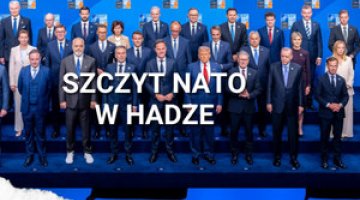NATO’s Eastern Flank – a new paradigm
Cooperation: Piotr Szymański, Tomasz Dąborowski
The decisions made at the NATO summit in Warsaw mark a paradigm shift in the policy of strengthening the alliance’s presence on its eastern flank. NATO is shifting from a policy of reassuring its allies (which was agreed upon in 2014) to taking its first steps in a policy of deterrence towards Russia. Following the decisions made in Warsaw, Poland has secured a large US military presence on its territory. The Warsaw summit took also the demands of the Baltic states into account. Nevertheless, it may be expected that Lithuania, Latvia and Estonia will put forward proposals of a further enhancement of NATO land, maritime and air defence forces in their territories. Initiatives that Romania put forward before the summit have not received NATO’s full support but it will gradually increase its military presence also in the Black Sea region.
The decision to deploy four battalion-sized battlegroups in Poland and the Baltic states is an important measure, but it is only one of the elements of NATO’s entire deterrence strategy. Following the Warsaw summit it will be necessary to undertake a series of actions to enable effective co-operation between all the elements in the NATO chain of military response. Implementation of the summit’s decisions, adjustment of structures and processes may be confronted with political challenges. These decisions may be seen by certain NATO members from Western Europe as a sufficient political signal for Russia, a signal which not only dispenses of further adjustments at a military level but which should also be counterbalanced with intensified co-operation with Moscow that includes some of Russia’s demands regarding the adjustment of the European security architecture. The consequences of the upcoming elections in the US and Germany as well as developments in the UK may also present challenges to the credibility of NATO’s deterrence policy.
From reassurance to deterrence
The decisions made at the Warsaw NATO summit mark a shift in the nature of NATO’s presence on its eastern flank. NATO is switching from its policy of reassuring its allies (which was agreed at the Wales summit in 2014) to taking its first steps in a policy of deterrence towards Russia. It is a substantial change given the differences in perceiving the challenges and threats among the states of NATO’s southern and eastern flanks and divergences among NATO members regarding the formation of policy towards Russia.
The NATO summit in Wales (2014) was held several months after the annexation of Crimea. The decisions made there were above all aimed at assuring eastern NATO member states of the alliance’s solidarity. The agreed strengthening of NATO’s presence on its eastern flank was, however, not of great military significance. It allowed for a rotational presence of NATO small company-sized units (approximately 150 troops) in terms of exercises and training and an increased participation in exercises of land, air and maritime forces. Due to a lack of agreement within NATO over an enhanced military presence on its eastern flank, NATO focused on reforming its support forces – the NATO Response Forces (NRF) and within it a brigade-sized (approximately 5,000 troops) Very High Readiness Joint Task Force (VJTF). Should a conflict with Russia occur, these forces would be quickly deployed from where they are stationed to NATO’s eastern flank (see Appendix).
The decisions made at the NATO summit in Warsaw (2016) have changed the nature of the alliance’s involvement on its eastern flank. With regard to Russia’s aggressive policy, NATO’s members have deemed it necessary to ensure a larger presence of NATO forces suited for combat, not exercises. There has not been an agreement within NATO to permanently station allied forces; this would run contrary to the NATO-Russia Founding Act for Germany (among other countries). Despite that it has been agreed that four battalion-sized battlegroups (totalling approximately 1,000 troops), fully armed and provided with military equipment, will be deployed on a persistent rotational basis beginning in the first quarter of 2017 (see Appendix). Battalion-sized battlegroups are not the forces which will ensure the defence of Poland or the Baltic states in the face of Russia’s potential aggression since this would require the deployment of several NATO brigades in the region at least. There is no political agreement or readiness within NATO to invest bigger funds for that and in the case of the Baltic states - it is simply unfeasible to station such large forces there at the moment. It is assumed that four battlegroups, engaged in fighting in the event of Russian aggression will be an element which will trigger the chain of NATO military response and will engage the alliance in a conflict with Russia. Their presence aims to deter the Kremlin from undertaking aggressive actions – Moscow can no longer count on NATO avoiding a reaction and it must also calculate the implications of the engagement of US, German or British troops in a potential conflict.
NATO’s eastern flank after the Warsaw summit
The Warsaw summit has shown that the term ‘NATO’s eastern flank’ refers mainly to Poland, the Baltic states and Romania. These states have a similar perception of Russia and have demanded an increased NATO presence in their territories. They see the Russian political system and foreign policy goals as a threat to their security and sovereignty. Poland’s partners from the Visegrad Group have a different view on the challenges and threats to their security. They do not perceive a direct threat from Russia and are not demanding the deployment of NATO forces in their countries. However, during the summit they supported Poland, the Baltic states and Romania in their efforts to step up the presence of NATO forces. The rotational presence of one company from the Czech Republic, Slovakia and Hungary in the Baltic states will be a symbolic manifestation of their solidarity. As for NATO’s policy of deterrence, these countries have adopted, to a large extent, Germany’s position. In the case of the Czechs and the Slovaks, this comes partly as the result of many diverging voices in the ruling elites regarding the shape of policy towards Russia. Also Bulgaria has a different perspective on the challenges and threats than its neighbour, Romania. This is caused by a host of factors such as an aversion to the ‘militarisation’ of the Black Sea region (following the Warsaw summit, Bulgaria’s prime minister even suggested making the Black Sea a ‘demilitarised zone’) and its economic ties with Russia.
Following the decisions made at the Warsaw summit, Poland will secure a large US military presence in its territory. The US will become a framework state for the battalion-sized battlegroup in Poland – this group will be the most homogeneous in terms of its composition (up to 1,000 American troops, supplemented by British and Romanian companies), which will influence its actual combat readiness. Furthermore, a multinational division headquarters will be established based on the Polish division headquarters. It will be responsible for commanding all battalion-sized battlegroups and will be subordinated to the Headquarters Multinational Corps Northeast in Szczecin. Negotiations are also underway over the location of NATO centre for intelligence and reconnaissance in Poland. Additionally, under the American European Reassurance Initiative (ERI) a US division headquarters and the main components of the US heavy-armoured brigade will be deployed in Poland; they will start exercises in the Baltic states, Poland, Romania and Bulgaria in 2017. Furthermore, in May 2016 construction was launched of the US SM-3 missile defence base in north-western Poland (Redzikowo) forming part of the NATO missile defence system.
The Warsaw summit has responded to demands presented by the Baltic states whose chiefs of defence in May 2015 called for the deployment of strengthened battalion-sized units in each of their states. The dislocation of battlegroups numbering approximately 1,000 troops in their territories will supplement their military potential – the armed forces of Lithuania, Latvia and Estonia comprise a total of 5,000 to 11,000 soldiers (without the territorial defence forces component). The Baltic states will seek to ensure that companies forming the battlegroups are heavily armoured, which will fill the gaps in their combat capabilities. However, compared to the situation in Poland, NATO battlegroups to be deployed in the Baltic states may have a lesser combat significance due to their frequent rotations, as well as possible communication and interoperability problems. They will be composed of units from several NATO member states which will support the main forces of the framework nations – Germany, Canada and the UK.
From the perspective of Lithuania, Latvia and Estonia there is a question about the further military engagement of the US in their territories. Will the US maintain the presence of its companies which have been rotating since 2014? Will it participate in the Baltic battlegroups or will it limit its engagement to involving units of its heavily-armoured brigade in exercises starting in 2017? The Baltic states may in future demand an increased presence of NATO troops in their territories – up to a brigade in each state. They are also interested in a NATO maritime presence in the Baltic (Latvia is calling for the establishment of a permanent base for NATO ships at the Liepaja naval base) and in maintaining a strengthened NATO Baltic Air Policing mission (BAP) and extending it to include ground-based air-defence systems.
Romania, which prior to the Warsaw summit had suggested initiatives intended to step up NATO’s presence in the Black Sea region in the form of a multinational brigade and a Black Sea fleet, has gained relatively modest support. However, NATO’s presence in the Black Sea region will be gradually extended. Regardless of decisions made at the NATO summit, US forces, linked with the US military presence in the Middle East and Africa, have been present in Romania (and Bulgaria) for years. The US has been using Romanian and Bulgarian military bases to dispatch US troops. Since 2010 both countries have secured the presence of US Marines (Black Sea Rotational Force) on a rotational basis. Furthermore, in May this year a US land-based SM-3 missile defence base in Romania was activated as an element of NATO’s missile defence system.
Following the decisions made at the Warsaw summit, Romania will form a multinational brigade based on a Romanian brigade. It will be also composed of companies from other member states – they will most likely participate on a temporary basis in exercises and training in Romania (Bulgaria and Poland have already announced they will make contributions to the brigade). The brigade will be under the command of the Headquarters of a Multinational Division Southeast in Bucharest that is integrated into the NATO command structure. Romania has not been guaranteed the establishment of a NATO Black Sea fleet; it has instead been promised that the prospect of strengthening the maritime and air presence of NATO in the Black Sea region will be analysed. It may therefore be expected that NATO will extend the participation of the allied ships in exercises at the Black Sea and of the allied fighter jets in strengthening of the air policing in Romania and Bulgaria (in September this year Poland will send its fighters, probably MiG-29).
Military deterrence to be further developed
The decisions to deploy battalion-sized battlegroups in Poland and the Baltic states is an important step but only one of the elements of NATO’s entire deterrence strategy. Following the Warsaw summit it will be essential to take a series of measures which will enable effective co-operation between all the elements in the NATO chain of military response. These steps will concern among others the following:
- Investments in early warning capabilities – this year’s NATO CMX exercise with elements of hybrid war have indicated that NATO must have better intelligence to make quicker political and military decisions.
- Transferring at least part of the responsibility for making decisions about the use of battalion-sized battlegroups or parts of the VJTF from the political level (North-Atlantic Council) to the military level (Supreme Allied Commander Europe). This has been favoured by the Baltic states and Poland.
- Adjusting operational level commands in NATO (JFC Brunssum and JFC Naples) in order to effectively run collective defence operations after years of concentrating on crisis management missions out of area.
- Subordinating NATO forces (battalion-sized battlegroups, the VJTF/NRF) to one chain of command and ensuring effective co-operation with US troops on the eastern flank and national armed forces.
- Developing a concept of follow-on forces which would support the VJTF/NRF in larger-scale conflicts.
- Increasing the speed of dispatching NATO forces to the eastern flank by road transport and by railway.
- Investments in military infrastructure in the countries on the eastern flank (air and naval bases, training grounds) to enable it to accommodate NATO forces larger than a brigade.
- Updating contingency plans with regard to NATO’s eastern flank and the decisions made at the Warsaw summit.
- Carrying out command post and field exercises based on collective defence scenario. This envisages the participation of all the components of NATO forces (battalion-sized battlegroups, the VJTF and the remaining NRF components), US troops in Europe, and the national armed forces of the countries on the eastern flank.
- Developing a strategy to step up the NATO air and maritime presence in the Baltic Sea and Black Sea regions.
- Adjusting the rhetoric and strategy in the area of NATO nuclear policy to Russia’s doctrine of using tactical nuclear weapons. The provisions of the Warsaw Summit Communiqué have signalled that NATO has noticed this issue; however, they are only an introduction to a discussion about this topic within NATO.
Political challenges following the summit
Implementing the decisions, adjusting military structures and political processes in order to create a cohesive and reliable deterrence strategy will be confronted with challenges, mainly of a political nature. The decisions made at the Warsaw summit may be regarded by certain NATO members from Western Europe as a sufficient political signal for Russia, a signal which not only dispenses with the need for further adjustments at the military level but which should also be counterbalanced with intensified dialogue and co-operation with Moscow, that takes into account some Russian proposals regarding European security. The possibility that some NATO member states will push for a revision of the decisions of the Warsaw summit in the coming years should not be completely ruled out.
The credibility of NATO’s deterrence strategy has been already challenged by certain statements made by representatives of member states. Prior to the Warsaw summit, Germany’s foreign minister, Frank-Walter Steinmeier, had criticised large-scale military exercises on NATO’s eastern flank (incidentally, with the participation of the Bundeswehr) based on the collective defence scenario. During the Warsaw summit France’s President, François Hollande, stated that for France Russia is a partner, not a threat, which is contradictory to the rhetoric of the Warsaw Summit Communiqué. These statements may be strengthened by a potential Donald Trump victory in the US presidential election (November 2016) since he may seek a reset of relations between the US and Russia. This might lead to a fall in US support for the NATO deterrence strategy and to limiting the US presence on NATO’s eastern flank. The campaign ahead of the parliamentary election in Germany (to be held in September 2017) may also force Chancellor Angela Merkel to refer to demands to strengthen the policy of dialogue and co-operation with Russia more often. The Social Democrats will seek to come across as a party of ‘peace and dialogue’ as opposed to the Christian Democrats who are ‘focused on confrontation’ and may demand a revision of the decisions of the Warsaw summit. Furthermore, an increasing engagement of NATO member states in crises and conflicts in Europe’s southern neighbourhood combined with insufficient funding for the military may strengthen demands for NATO’s presence on its eastern flank to be limited.
Appendix 1
Contributions to the battalion-sized battlegroups (as of July 2016)
|
|
Poland |
Lithuania |
Latvia |
Estonia |
|
Framework nation (number of troops)* |
US (1,000) |
Germany (600) |
Canada (450) |
UK (500) |
|
Contribution of other states** (number of troops) |
UK (150), Romania (150)
|
Norway (200), Netherlands (100–150), Belgium (150), Luxembourg (50), Croatia (150) France (150)*** |
Poland (150) Portugal (not yet confirmed) Italy (150, not yet confirmed) Slovenia (50, not yet confirmed)
|
Denmark (200) France(150)
|
*The framework nations will constantly rotate their forces, ensuring a persistent military presence.
**The remaining states will ensure periodic rotations, supplementing the forces secured by the framework nations.
***In 2018.
Appendix 2
The structure of the NATO Response Force (NRF) after the 2014 reform
|
Elements of NRF |
Size |
Readiness |
|
Very High Readiness Joint Task Force (VJTF) |
Land component: multinational brigade (approximately 5,000 troops) with components of air, maritime and special forces
Including one higher readiness battalion (approximately 650 troops)
Total number of VJTF troops – 20,000 |
5–7 days
48–72 hours |
|
Initial Follow-on Forces Group (IFFG) |
Land component: two multinational brigades
|
The first brigade – 30 days The second brigade - 45 days |
|
Response Forces Pool (RFP) |
No data available regarding size and composition. |
|
|
Elements of the NRF also comprise maritime and air components, special forces and CBRN. |
||
|
Total number of NRF troops – 40,000 |





